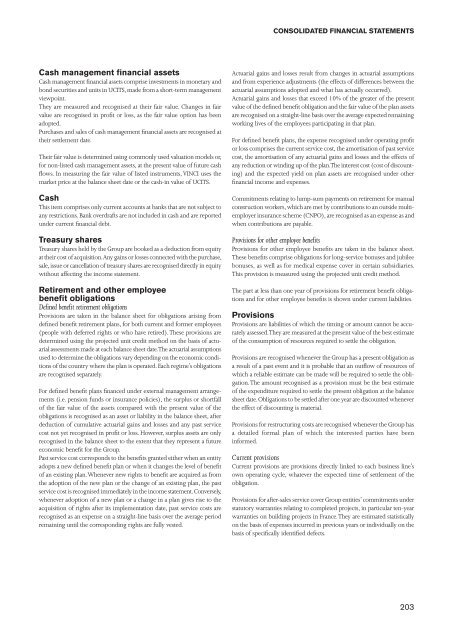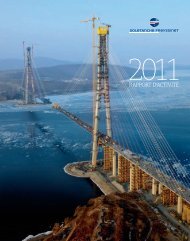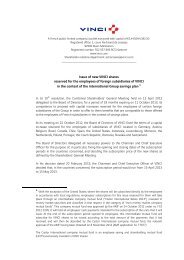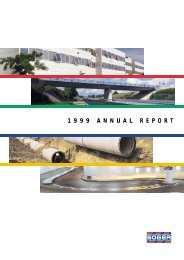VINCI - 2005 annual report
VINCI - 2005 annual report
VINCI - 2005 annual report
You also want an ePaper? Increase the reach of your titles
YUMPU automatically turns print PDFs into web optimized ePapers that Google loves.
Cash management financial assets<br />
Cash management financial assets comprise investments in monetary and<br />
bond securities and units in UCITS, made from a short-term management<br />
viewpoint.<br />
They are measured and recognised at their fair value. Changes in fair<br />
value are recognised in profit or loss, as the fair value option has been<br />
adopted.<br />
Purchases and sales of cash management financial assets are recognised at<br />
their settlement date.<br />
Their fair value is determined using commonly used valuation models or,<br />
for non-listed cash management assets, at the present value of future cash<br />
flows. In measuring the fair value of listed instruments, <strong>VINCI</strong> uses the<br />
market price at the balance sheet date or the cash-in value of UCITS.<br />
Cash<br />
This item comprises only current accounts at banks that are not subject to<br />
any restrictions. Bank overdrafts are not included in cash and are <strong>report</strong>ed<br />
under current financial debt.<br />
Treasury shares<br />
Treasury shares held by the Group are booked as a deduction from equity<br />
at their cost of acquisition. Any gains or losses connected with the purchase,<br />
sale, issue or cancellation of treasury shares are recognised directly in equity<br />
without affecting the income statement.<br />
Retirement and other employee<br />
benefit obligations<br />
Defined benefit retirement obligations<br />
Provisions are taken in the balance sheet for obligations arising from<br />
defined benefit retirement plans, for both current and former employees<br />
(people with deferred rights or who have retired). These provisions are<br />
determined using the projected unit credit method on the basis of actuarial<br />
assessments made at each balance sheet date. The actuarial assumptions<br />
used to determine the obligations vary depending on the economic conditions<br />
of the country where the plan is operated. Each regime’s obligations<br />
are recognised separately.<br />
For defined benefit plans financed under external management arrangements<br />
(i.e. pension funds or insurance policies), the surplus or shortfall<br />
of the fair value of the assets compared with the present value of the<br />
obligations is recognised as an asset or liability in the balance sheet, after<br />
deduction of cumulative actuarial gains and losses and any past service<br />
cost not yet recognised in profit or loss. However, surplus assets are only<br />
recognised in the balance sheet to the extent that they represent a future<br />
economic benefit for the Group.<br />
Past service cost corresponds to the benefits granted either when an entity<br />
adopts a new defined benefit plan or when it changes the level of benefit<br />
of an existing plan. Whenever new rights to benefit are acquired as from<br />
the adoption of the new plan or the change of an existing plan, the past<br />
service cost is recognised immediately in the income statement. Conversely,<br />
whenever adoption of a new plan or a change in a plan gives rise to the<br />
acquisition of rights after its implementation date, past service costs are<br />
recognised as an expense on a straight-line basis over the average period<br />
remaining until the corresponding rights are fully vested.<br />
CONSOLIDATED FINANCIAL STATEMENTS<br />
Actuarial gains and losses result from changes in actuarial assumptions<br />
and from experience adjustments (the effects of differences between the<br />
actuarial assumptions adopted and what has actually occurred).<br />
Actuarial gains and losses that exceed 10% of the greater of the present<br />
value of the defined benefit obligation and the fair value of the plan assets<br />
are recognised on a straight-line basis over the average expected remaining<br />
working lives of the employees participating in that plan.<br />
For defined benefit plans, the expense recognised under operating profit<br />
or loss comprises the current service cost, the amortisation of past service<br />
cost, the amortisation of any actuarial gains and losses and the effects of<br />
any reduction or winding up of the plan. The interest cost (cost of discounting)<br />
and the expected yield on plan assets are recognised under other<br />
financial income and expenses.<br />
Commitments relating to lump-sum payments on retirement for manual<br />
construction workers, which are met by contributions to an outside multiemployer<br />
insurance scheme (CNPO), are recognised as an expense as and<br />
when contributions are payable.<br />
Provisions for other employee benefits<br />
Provisions for other employee benefits are taken in the balance sheet.<br />
These benefits comprise obligations for long-service bonuses and jubilee<br />
bonuses, as well as for medical expense cover in certain subsidiaries.<br />
This provision is measured using the projected unit credit method.<br />
The part at less than one year of provisions for retirement benefit obligations<br />
and for other employee benefits is shown under current liabilities.<br />
Provisions<br />
Provisions are liabilities of which the timing or amount cannot be accurately<br />
assessed. They are measured at the present value of the best estimate<br />
of the consumption of resources required to settle the obligation.<br />
Provisions are recognised whenever the Group has a present obligation as<br />
a result of a past event and it is probable that an outflow of resources of<br />
which a reliable estimate can be made will be required to settle the obligation.<br />
The amount recognised as a provision must be the best estimate<br />
of the expenditure required to settle the present obligation at the balance<br />
sheet date. Obligations to be settled after one year are discounted whenever<br />
the effect of discounting is material.<br />
Provisions for restructuring costs are recognised whenever the Group has<br />
a detailed formal plan of which the interested parties have been<br />
informed.<br />
Current provisions<br />
Current provisions are provisions directly linked to each business line’s<br />
own operating cycle, whatever the expected time of settlement of the<br />
obligation.<br />
Provisions for after-sales service cover Group entities’ commitments under<br />
statutory warranties relating to completed projects, in particular ten-year<br />
warranties on building projects in France. They are estimated statistically<br />
on the basis of expenses incurred in previous years or individually on the<br />
basis of specifically identified defects.<br />
203
















